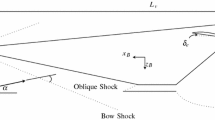Abstract
The dynamic decoupling problem of the hypersonic flight vehicle (HFV) is considered in this paper. The Linear Parameter-Varying (LPV) model of the HFV is firstly obtained and smoothly transformed into a polytopic form by the Tensor-Product (TP) model transformation method. After that, a dynamic decoupling control method is derived by minimizing the H ∞ norm of a virtual system, which is composed by the controlled system and the no coupling reference model. The necessary and sufficient condition for the existence of the controller is derived based on Linear Matrix Inequalities (LMIs). Next, the decoupling controller for the polytopic LPV model of HFV is designed. And the simulation results show that the proposed method has perfect performance in terms of dynamic decoupling.
抽象
创新点
本文考虑的是高超声速飞行器的动态解耦问题. 首先建立了高超声速飞行器的线性参变模型, 采用张量积模型转换法将其转换为多胞形式.
然后, 将该被控对象与待求控制器组成的闭环系统和一个无耦合的参考模型组成一个虚拟系统, 通过最小化该虚拟系统的 H 无穷范数来求解动态解耦跟踪控制器, 并用线性矩阵不等式的形式给出了存在该控制器的充分必要条件. 最后, 利用提出的定理求得具有相同多胞形式的解耦控制器, 并且针对飞行轨迹中具体的一点进行耦合度和跟踪性能的分析, 结果表明本文提出的方法在动态解耦方面有非常好的效果.
Similar content being viewed by others
References
Xu B, Shi Z K. An overview on flight dynamics and control approaches for hypersonic vehicles. Sci China Inf Sci, 2014, doi: 10.1007/s11432-014-5273-7
Chen X Q. Study of maneuvering technology for hypersonic gliding vehicle (in Chinese). Dissertation for the Doctoral Degree. National University of Defense Technology, 2011
Lei Y H, Chen S L. The missile aerodynamic coupling analysis and decoupling arithmetic study (in Chinese). J Balliist, 2003, 15: 11–16
Qi N M, Zhou Q H, Qin C M. The six DOF model of hypersonic vehicle and coupling characterization analysis (in Chinese). Journal of Proj Rocket Missiles Guid, 2012, 32: 49–52
Chui S, Chand S, Moore D. Fuzzy logic for control of roll and moment for a flexible wing aircraft. IEEE Contr Syst Mag, 1991, 11: 42–48
Zhou H L, Liu Z Y. Vehicle yaw stability-control system design based on sliding mode and backstepping control approach. IEEE Trans Veh Technol, 2010, 59: 3674–3678
Hawkins D J. Pseudodiagonalisation and the inverse Nyquist array method. Proc IEE, 1972, 119: 337–342
Edmunds J. Input and output scaling and reordering for diagonal dominance and block diagonal dominance. Contr Theory Appl, 1998, 145: 523–530
Chen C L, Munro N. Procedure to achieve diagonal dominance using a PI/PID controller structure. Int J Contr, 1989, 50: 1771–1792
Bryant G F, Yeung L F. Multivariable Control System Design Technique: Dominance and Direct Methods. England: Elsevier Ltd, 1997. 112–151
Laya S, Afsoon N, Amin N, et al. Design of low order dynamic pre-compensators using convex methods. In: Proceedings of American Control Conference, San Francisco, 2011. 3680–3685
Rosenbrock H H. Design of multivariable control systems using the inverse Nyquist array. Proc Inst Electr Eng, 1969, 116: 1929–1936
Mayne D Q. The design of linear multivariable systems. Automatica, 1973, 9: 201–207
Nobakhti A, Munro N. A new method for singular value loop shaping in design of multiple-channel controllers. IEEE Trans Automat Contr, 2004, 49: 249–253
Fu Y, Chai T Y, Su C Y, et al. Intelligent decoupling control of nonlinear multivariable systems. In: Proceedings of the 46th IEEE Conference on Decision and Control, New Orleans, 2007. 1350–1355
Tong C X, Wang Z J, Zhang T Q. Decoupling system design based on variable structure system for BTT missile (in Chinese). J Astronaut, 2006, 27: 27–30
Li H. Design of multivariate fuzzy-neural network decoupling controller (in Chinese). Contr Dec, 2006, 21: 593–596
Xu B, Gao D X, Wang S X. Adaptive neural control based on HGO for hypersonic flight vehicles. Sci China Inf Sci, 2011, 54: 511–520
Xu B, Huang X Y, Wang D W, et al. Dynamic surface control of constrained hypersonic flight models with parameter estimation and actuator compensation. Asian J contr, 2014, 16: 162–174
Tutuncu R H, Toh K C, Todd M J. Solving semidefinite-quadratic-linear programs using SDPT3. Math Program Ser B, 2003, 95: 189–217
Lofberg J. Automatic robust convex programming. Optim Method Softw, 2012, 27: 115–129
Scherer C, Gahinet P, Chilali M. Multiobjective output-feedback control via LMI optimization. IEEE Trans Automat Contr, 1997, 42: 896–911
Chughtai S S, Nobakhti A, Wang H. A systematic approach to the design of robust diagonal dominance based MIMO controllers. In: Proceeding of the 44th IEEE Conferrence on Decision and Ccontrol, Sevilla, 2005. 6875–6880
Wang M H, Liu G, Zhao P T, et al. Variable gain state feedback H ∞ control for hypersonic vehicle based on LPV (in Chinese). J Astronaut, 2013, 34: 488–495
Petres Z. Polytopic decomposition of linear parameter-varying models by tensor-product model transformation. Dissertation for the Doctoral Degree. Budapest: Budapest University of Technology and Economics, 2006
Huang Y Q, Sun C Y, Qian C S, et al. Non-fragile switching tracking control for a flexible air breacthing hypersonic vehicle based on polytopic LPV model. Chin J Aeronaut, 2013, 26: 948–959
Yam Y, Baranyi P, Yang C T. Reduction of fuzzy rule base via singular value decomposition. IEEE Trans Fuzzy syst, 1999, 7: 120–132
Lofberg J. YALMIP: a toolbox for modeling and optimization in MATLAB. In: Proceedings of IEEE International Symposium on Computer Aided Control Systems Design, Taipei, 2004. 284–289
Author information
Authors and Affiliations
Corresponding author
Rights and permissions
About this article
Cite this article
Lan, X., Wang, Y. & Liu, L. Dynamic decoupling tracking control for the polytopic LPV model of hypersonic vehicle. Sci. China Inf. Sci. 58, 1–14 (2015). https://doi.org/10.1007/s11432-015-5339-1
Received:
Accepted:
Published:
Issue Date:
DOI: https://doi.org/10.1007/s11432-015-5339-1




